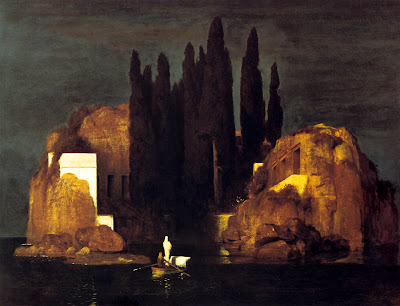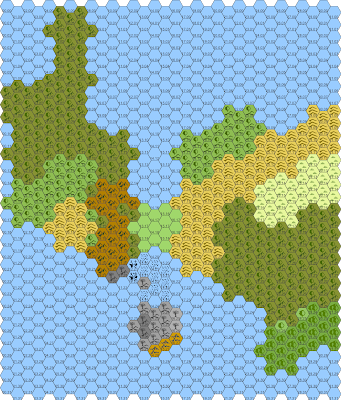 |
| Arnold Böcklin’s Isle of the Dead |
Conspectus: Resting on warm but brooding seas, the Idle of the Dead is a palimpsest of ruins. Many different civilizations have in the past settled on the Isle. The wilderness is haunted by the hidden realms of Faerie, visible only to those with the second sight. The Isle is scattered with abandoned colonies, restless dead, ghost towns, and the cast-off outposts of past inhuman visitors. The fragile but tenacious settlements of recent colonists cling to the coasts and ply the shallow seas. Spirits and wizard kings have set themselves up as petty gods demanding worship and tribute.
The primary visual inspiration is obviously Böcklin’s piece above, but I’ll post more images in the future. I don’t want to clutter this post up too much. Here is information about some of the past inhabitants.
The Monument Builders. Their works are crude but of immense scale. No one knows anything else about them.
The Old Empire. This was a civilization of tremendous advancement. They built wonders of engineering including bridges, aqueducts, soaring towers, and cities beneath the ground. Little is known about the society of the Old Empire. In fact, it is unknown whether it even was an empire. It is assumed to have been an empire due to the vast extent and uniformity of obviously related ruins. It is so old that nothing is known of its history or rulers, and few artifacts other than the architecture itself has survived. Many Old Empire structures have been repurposed by later settlers.
The Visitors. These ruins are obviously not of human origin and sometimes contain strange devices. Sages differ on whether the remnants of the Visitors came before or after the Old Empire.
The Hundred Kingdoms. The beginning of written history as far as most scholars are concerned. For the most part, the kingdoms did not extend to the Isle, though there are ruins of small outposts, perhaps the homes of heretics or outcasts. Other islands, and of course the mainland to the east, are the primary sources of Hundred Kingdoms ruins. The religion of the Kingdoms held that past the western seas lay the land of the dead. Some believe this is the origin of the name Isle of the Dead.
The Great Empire. The Great Empire arose on the mainland to the east when the Hundred Kingdoms were unified.
The First Expedition. During the zenith of the Great Empire, armies and settlers were sent in all the directions of the compass to explore and subdue. This was the first of two waves of colonization, and was a direct political extension of the metropole. Not much is known about these earlier colonies because after several generations contact was lost. The legend is that they rebelled against the homeland and so were cursed by the gods. That was 500 years ago.
The Second Expedition. Founded approximately two hundred years ago, the Second Expedition followed in the disastrous footsteps of the First. Unlike the First Expedition, the Second was led by adventurers and frontierspeople. At this time, the Great Empire was in a more inward-looking mood. When the settlers arrived, all they found were ruins and ghost towns. Initially, the colonies flourished, and spread around the edges of the Isle. Trade and commerce with the homeland was strong, but over time fewer and fewer ships returned until there was no contact. It has been two generations since the last successful voyages, and many assume the Great Empire has either suffered some disaster or disintegrated once more into feuding kingdoms.
The point of this detail is not to have an extensive history, but to allow me to differentiate between different types of ruins, and to create meaningful connections between them. I am trying to avoid engaging in world building for its own sake, so if something doesn’t add to the experience of the game as game, I don’t want to spend (much) time on it. I’m trying to build from the bottom up as much as possible, but I find I still need some level of thematic framework before I can begin creating domains and points of interest on the map.
As I have been detailing this setting, many things have surprised me. For example, the degree of Mediterranean influence. I wasn’t really planning that to begin with. And the influence of the sea. I guess I will need to become more familiar with nautical rules.







